We moved from Gabriola Island to North Vancouver two months ago and I’m just beginning to get the hang of urban birding. It’s quite different from backyard birding, since I don’t have a yard full of feeders, bird baths, a pond, or plants, like this Trumpet Vine in bloom, to attract birds. Those were the days.
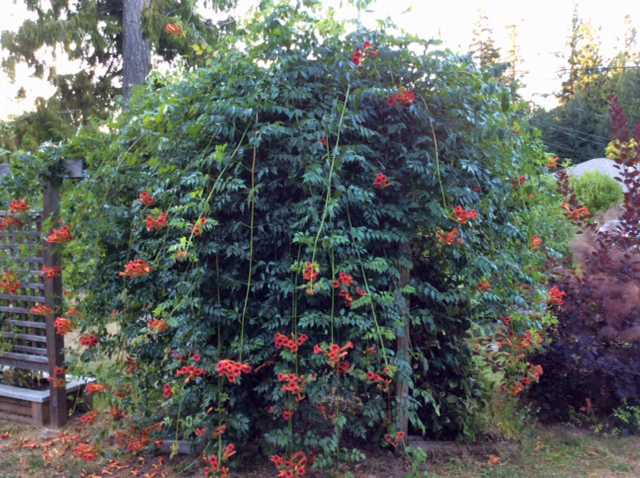
Our Trumpet Vine (Campsis radicans) attracted a Western Tanager pair every year.
Here, on the twenty-second floor of Marlborough Tower, I keep my binoculars handy, one pair at the kitchen window and one pair on the deck, and spend more time than I like to admit watching the dozen pigeons, those unjustly-maligned doves-by-another-name that hang out on the library roof next door. (What do they eat up there? And why do they walk in circles?) Nathaniel Johnson devotes a fascinating chapter to them in his 2016 memoir-of-sorts,“Unseen City: the Majesty of Pigeons, the Discreet Charm of Snails, & Other Wonders of the Urban Wilderness”. I recommend it.
I’m also becoming mildly obsessed by the Glaucous-winged Gulls nesting on the same roof. Every time I go by the kitchen window, dozens of times a day, maybe more, I check on them. The gull nesting closest to our building lies in clear view of predators and has no respite from the sun; the choice of nesting location seems precarious.
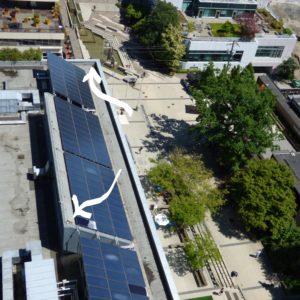
The solar roof of the library with arrows showing the two gulls’ nests.
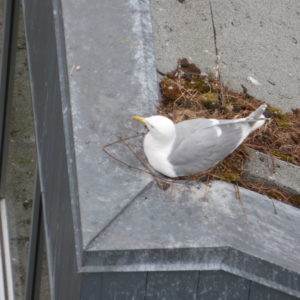
Close-up of Glaucous-winged Gull on nest with 3 spotted multi-coloured eggs
iBird Canada says the parents share incubation duties but I’ve only seen them change places once. Of course, I’m not watching 24/7. Not quite. The gull who’s not on the nest also chases away crows that venture too close. But during much of the day he (I’m assuming it’s the father) is out and about. At dusk, though, he returns to sleep close by. Both of them ignore the pigeons that roost on the roof, I assume because gulls are known to eat pigeons, so they’re not a threat — right now. Will that change when the eggs hatch?
Glaucous-winged Gulls incubate their eggs for 26 to 29 days – if all goes well. I realize I’m anthropomorphizing like crazy but honestly, sitting on an exposed roof for 29 days? In the hot sun? Barely moving? Rarely eating? It seems heroic, to say the least.
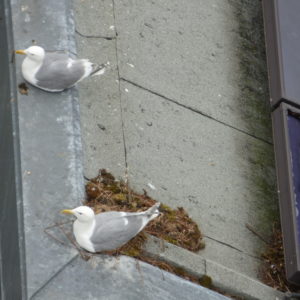
The couple
The young leave the nest two days after hatching but won’t be ready to fledge for 37-53 more days. At first this alarmed me. What will they do on the library roof – exposed to predators and the summer sun – for all that time? Then I saw the pigeons emerging from under the solar panels and realized the gulls probably know exactly what they’re doing. Obviously. What could be safer? And warmer?!
But not all the bird action is on the roof next door. When I step outside our building, I see Red-shafted Flickers poking for ants on the meridian full of delightfully unkempt perennial native plants – ferns, Saskatoon Berry, Goldenrod, dandelions, salal, grasses.
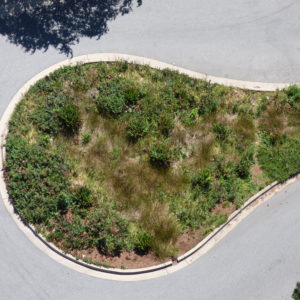
The boulevard full of native plants and “weeds” is habitat for a couple of flickers.
House Sparrows twitter in the trees. Bees collect nectar from the California Lilac in the small garden in front of the building. And two gorgeous crows hang out on the plaza as if they own it, proud and fearless.
There weren’t a lot of crows on Gabriola so having the chance to observe these ones up close is a treat. Intrigued, I picked up Crow Planet by Lyanda Lynn Haupt at the library as well as her The Urban Bestiary: Encountering the Everyday Wild. Lyanda urges city-dwellers to immerse themselves in the wildness that exists right under their noses. (Or roofs?) I like Bill McKibben’s comment on the back of Crow Planet: “The fiction … that you can escape from nature by living in the city is as sad as it is widespread. This book will remind you to open your eyes to the mundane – it will make the city a far richer place for you.” Yes.
So will the surprise appearance of a Grey squirrel (actually black) emerging from one’s closet in the morning. Fortunately, this one appeared to know his way around, and quickly made his way onto my desk by the window and out that same window onto the ledge along the building. I wonder if he’d come in during the rainstorm that night and slept curled up in the laundry basket? On the way down in the elevator later a neighbour told me she often has one help himself to the bowl of pistachio nuts on her kitchen table. She’s not impressed.
In any event, I’m happy keeping my eyes open “to the mundane” but I’m also interested in seeing other birds – Vancouver is home to 267 species – so I have to be intentional, get off my duff and go places. I can walk to Victoria Park and Mahon Park. And there’s no end of birding hot spots accessible by bus. Maplewood Flats Conservation Area, for example, run by the Wild Bird Trust (http://www.wildbirdtrust.org/), hosts the North Shore’s first wildlife sanctuary, boasting a species list of 249. It’s also home to one of BC’s largest Purple Martin colonies. On a leisurely walk there the other day, my friend and I saw Great Blue Herons, Pelagic Cormorants, Spotted Towhees, Song Sparrows, House Finches, a Downy woodpecker, Black-capped Chickadees, swallows, gulls, crows, robins, and Swallowtail butterflies. The trails are flat and well-maintained. I’m already planning my next visit.
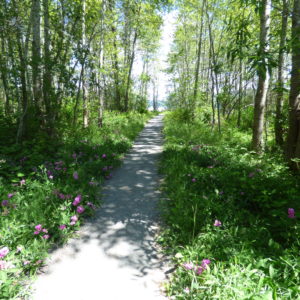
Maplewood Flats Conservation Area — a sun-lit trail.
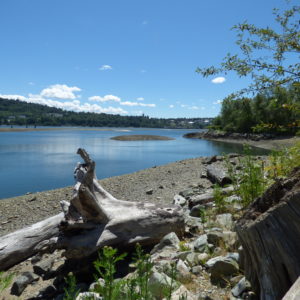
Maplewood Flats rests along Burrard Inlet
Pierre Cenerelli took this lovely photo of a Rock Wren in 2016 at Maplewood Flats. What a find!
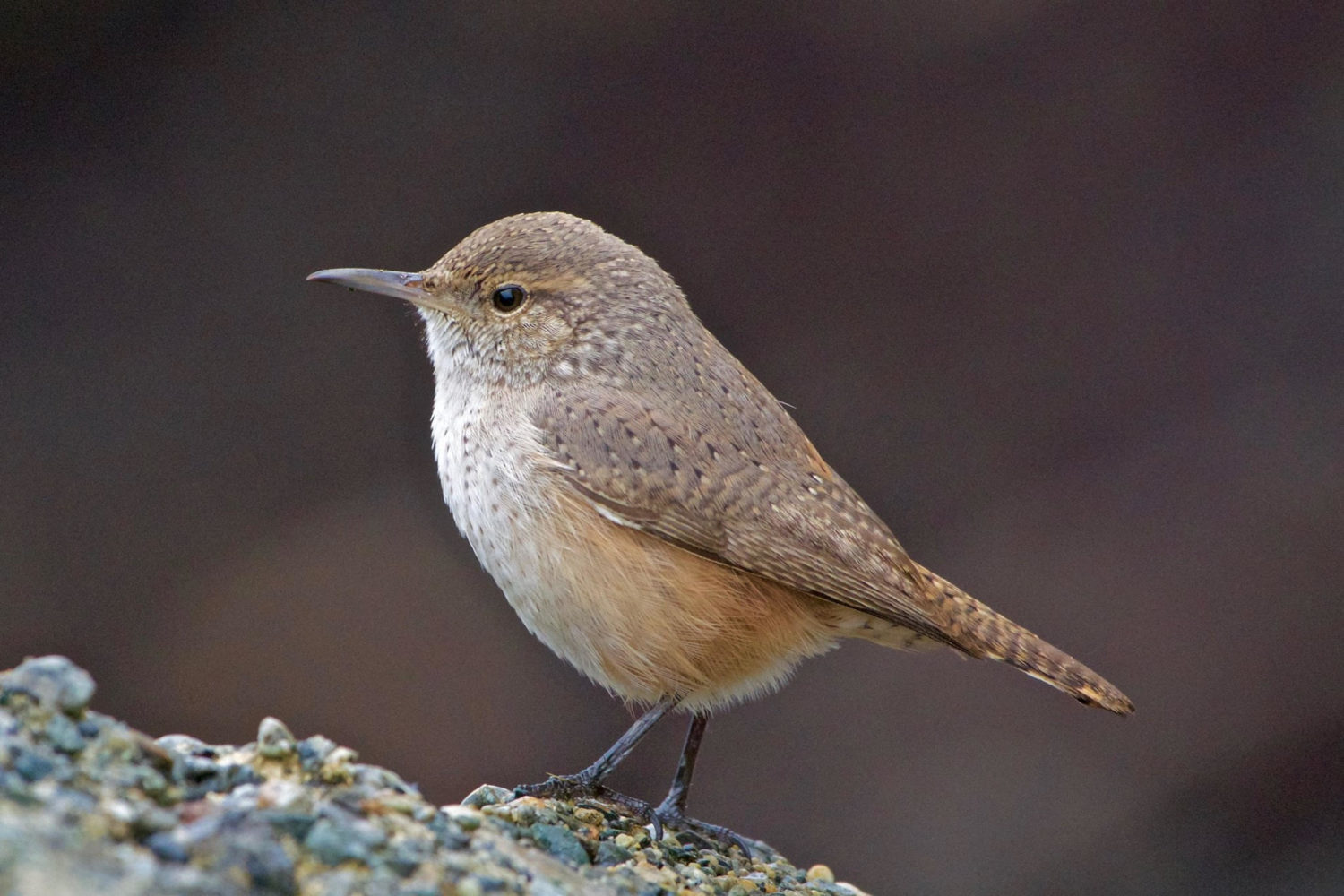
Photo ©Pierre Cenerelli. Rock Wren | Salpinctes obsoletus: This amazing bird was been only for a brief period in September 2016 at Maplewood Flats Conservation Area in North Vancouver, but I was lucky enough to get some good photos of it, including this one. It was busily and quite successfully feeding on some rocks by the ocean, far from its usual stomping grounds.
The North Shore — where the CROSS signal at pedestrian crosswalks is almost identical to the call of a Red-shafted Flicker, leading me to spend an inordinate amount of time scanning for flickers the first few weeks I was here — is also home to four expansive parks: Lighthouse, Mount Seymour Provincial, Cypress Provincial, and Ambleside. This photo of a Bufflehead on the Ambleside Park pond is courtesy of Pierre.
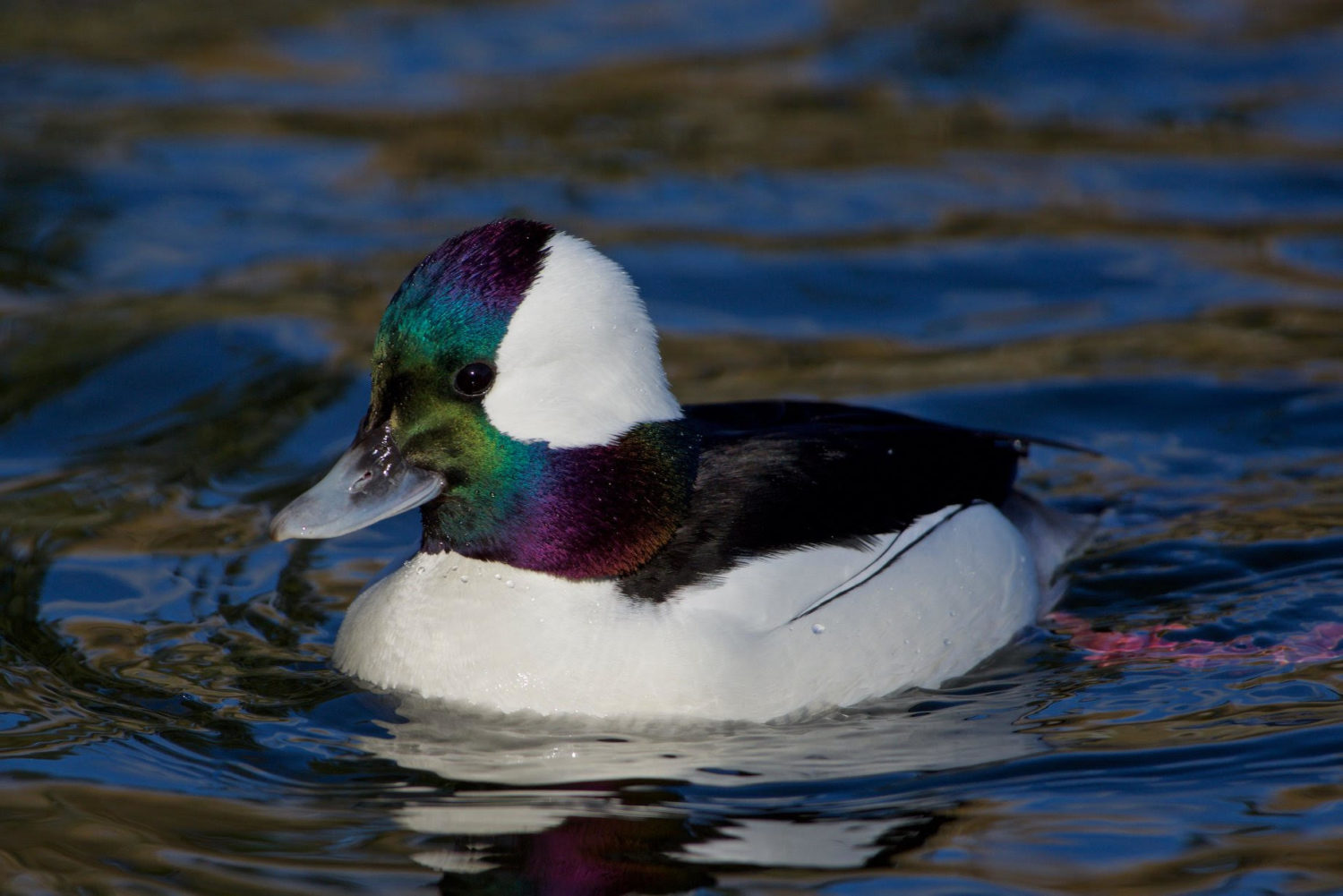
Photo ©Pierre Cenerelli. Bufflehead | Bucephala albeola: This beautiful male Bufflehead struck a few poses for me, but it should be mentioned that the ducks at this pond are regularly fed by humans and so approach them far more readily than normal. Still, the angle of the sun was perfect in this photo, showing off the Bufflehead’s iridescent head in all its splendour. Ambleside Park pond, West Vancouver (British Columbia), February 2018
And just a 15 minute bus ride away from Marlborough Tower is world famous Stanley Park, whose coastline is a designated Important Bird Area called English Bay/Burrard Inlet. In early June, Dennis and I went to visit the famous Great Blue Heron Rookery there. This year there are 29 nestlings. You can watch them day and night on the City of Vancouver nest cam: http://vancouver.ca/parks-recreation-culture/heron-cam.aspx. These majestic birds have been nesting in the trees by the Vancouver Parks Board building since 2001. This sub-species (Ardea herodias fannini) is a non-migratory heron designated a species-at-risk and is monitored by the Stanley Park Ecology Society. (http://stanleyparkecology.ca/)
As we head into summer I’m looking forward to visiting Pacific Spirit Park, Queen Elizabeth Park, Burnaby Lake Park, the UBC Botanical Gardens, VanDusen Gardens, and the Bloedel Conservatory, where 200 birds fly freely among 500 species of plants and bushes within the dome. And Lost Lagoon at Stanley Park! Pierre took this photo of a Hooded Merganser there.
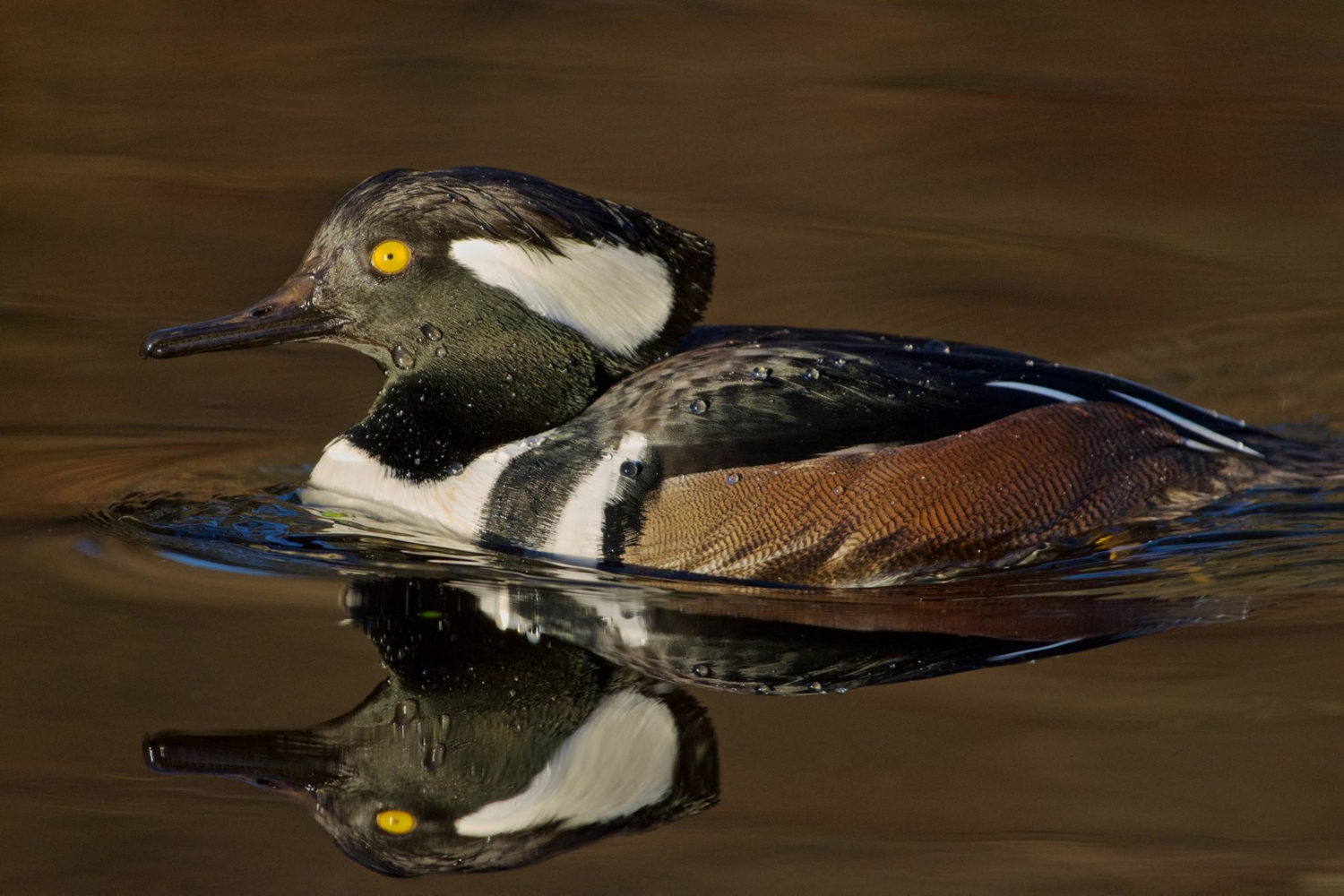
Photo ©Pierre Cenerelli. Hooded Merganser | Lophodytes cucullatus: I found and photographed this very cooperative male Hooded Merganser (who was accompanied by a female) on the tributary west of Lost Lagoon in Stanley Park in December 2017.
As well as countless opportunities to observe birds, there are many bird-related events and activities. A major one this summer is the 27th International Ornithological Congress, from August 19 to 26, expected to draw over 2000 international birders to Vancouver. http://www.iocongress2018.com/about. For non-scientist birders, like me, the Vancouver International Bird Festival (VIBF) takes place at the same time. The festival will include speakers, over 50 field trips, an art show, bird films at Science World, a photo contest, and a parade of birds on stilts. Most VIBF events are free! Needless to say, I’ll be there.
It’s going to be a busy summer in the city. I look forward to sharing my discoveries with you. Until next month … here’s to urban birding!
Many thanks to Pierre Cenerelli for his lovely photos. To see more, check out his Facebook page at https://www.facebook.com/avesimago or Instagram at https://www.instagram.com/pierrecenerelli.
If you’d like to be on the email list to get a note every month when I post a new article, just tell me that in the comment section and I will happily add your name.



Pingback: The Canada Day Gulls - Bird Canada
Thanks Rae!
Now I know where our doves went! We’ve had a lovely couple months watching the doves dive at the crows but suddenly they all disappeared! Entertaining.
Love your article.
Will do! Thanks for your interest!
Glad you enjoyed the post, Mary. Good luck with the crows!
Thanks, Garry! All the best to you too!
Beautiful!
Yes please add me to your mail list, thanks.
What a wonderful recounting of your birding adventures in our city – it encourages me to be ever more alert to the birds about me and perhaps not be so annoyed at the crow cawing and clearing my back yard at 5 in the morning. Perhaps I’ll get up, go out and see what is happening and hope I won’t be ‘bombed’!
Sharon, I can feel your enthusiasm and energy in this article, what wonderful discoveries you’re making, and I’m so pleased to feel the absolute joy you have finding birds and exploring the urban habitat right outside your window. I’m reminded of a few trips, years ago, that I’ve taken to Maplewood Flats, and thinking of the Purple Martins project, and the Ospreys. What a gem to have right in the neighbourhood practically. Love the pictures too, such vibrant detail. And the sweet Rock Wren is absolutely lovely. Thanks! All the best, Garry